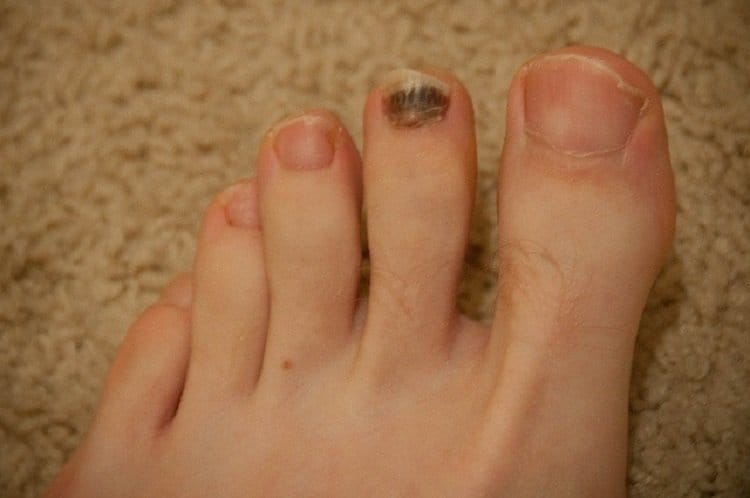The causes for splinter hemorrhage can be many. It could be a simple bump on the table where your capillaries break and there’s slight bleeding, or it could be something more ominous, such as endocarditis. In the end, pinpointing the cause is important because it’ll influence the way you deal with the disease.
So, in this article, we’ll be covering all the known causes of splinter hemorrhages (and the most common ones), while also talking about what you can do to cure the symptoms. Keep in mind that while you shouldn’t leave a splinter hemorrhage with no care or solution for too long, they generally aren’t dangerous and usually ‘grow out’ of the nails (by natural nail-growing, which can take a couple of months). Again, it all depends on the causes, so let’s cover them first.
Splinter Hemorrhages Causes

Bacterial Endocarditis
This is the most dangerous cause behind a splinter hemorrhage and the main reason why you should always visit a specialist, unless you’ve simply bumped your nail (we’ll cover this a bit later).
Bacterial endocarditis is a bacterial infection which is caused by bacteria that enter your bloodstream and fix themselves in your heart (heart lining, blood vessel, or heart valve). It isn’t a common health issue, but if you already have heart disease, you have a greater chance at developing it.
This disease can be fatal if left untreated, but antibiotics do the job quite well (there are cases where surgery is needed, but this happens to around 25% of the patients).
Fungal Infection of the Nail
Fungal nail infections aren’t uncommon. They aren’t as dangerous as endocarditis, but they are quite annoying because you might develop a feeling of pain in the infected toe. On top of that, if it’s left untreated for long, your entire foot may start being painful.
The older your nail, the bigger the chance it develops a fungal infection (due to it becoming increasingly more brittle and dry). Any cracks in the nail are an open the door to fungi.
Diabetes
If you wake up one day with a splinter hemorrhage in one or more nails, rush to the doctor. You may have diabetes. This is due to the fact your body is experiencing a spike in glucose levels; which can further cause damage to blood vessels since they can’t handle so much glucose.
It’s unfortunate, but it’s not the main cause of a splinter hemorrhage (but you should still visit a doctor to check on it, to be sure).
Nail Psoriasis
Psoriasis, in general, is an autoimmune disease which causes red and scaly patches on your skin. When it comes to nails, they may start to crack more easily, get a different color (i.e., yellow), or start separating from the nail bed as well.
Nail fungus can also be the cause of psoriasis, so they’re connected.
Injury to the Nail
And lastly, we have the classical “Ow, and I hurt my toe on the table!” This might be the leading cause of splinter hemorrhages simply due to how often people stub their toes on stuff. If the impact is hard enough, small blood spots (splinter hemorrhage) may appear. This hemorrhage cause isn’t something to worry about because it’ll disappear over time.
Splinter Hemorrhages Treatment Options
Drink Plenty of Water

The easiest out of all the treatments – all you have to do is increase your water intake. The more water you drink, the quicker and faster your nails will grow. So, if the cause of your splinter hemorrhage is something that isn’t dangerous to your health, drinking lots of water will help.
You might also want to consider drinking a charcoal tablet or two over the course of one week. These will help your body get rid of toxins quicker, thus enabling your nails to be stronger as well.
Eating a Diet that is High in Vitamin B

Vitamin B and Zinc are essential for the health of your nails. That’s why some nail polish contains lots of zinc – to strengthen the nails and get rid of the brittleness.
When it comes to food that’s rich in Vitamin B, you won’t have to be picky: avocados are great, and so are kidney beans. Red meat, poultry, and fish are also great sources of Vitamin B. Top it off with some broccoli and spinach, and there’s no reason why you can’t make an amazing meal with these foods!
Medical Treatment
If all else fails, you’ll need to visit a medical specialist. Besides, if you suspect the cause of your splinter hemorrhages is something dangerous such as endocarditis or diabetes, it’s better to just seek medical treatment in the first place. Don’t wait too long for the see results with alternative treatments as time can be precious.
References:
https://www.medicalnewstoday.com/articles/319108.php
https://www.healthline.com/health/fungal-nail-infection
https://familydoctor.org/condition/bacterial-endocarditis/
https://medlineplus.gov/ency/article/003283.htm

